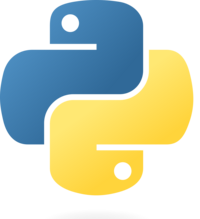Usuario:Lmorillas/intropyaytozgz/inmersionpython
De WikiEducator
< Usuario:Lmorillas | intropyaytozgz
Revisión a fecha de 20:31 12 nov 2012; Lmorillas (Discusión | contribuciones)
Saltar a: navegación, buscar
Contenido
Inmersión en Python
Luis Miguel Morillas @lmorillas
¿PYTHON?
- Interpretado, pero compilado a bytecode.
- Tipado dinámico, pero fuertemente tipado
- Multiplataforma
- Orientado a objetos
- Sintáxis sencilla pero muy robusta.
- Fácil de escribir, de leer y de mantener.
- Baterías incluidas
EL INTÉRPRETE
>>> print "Hola, mundo"
Hola, mundo
>>> impuesto = 12.5 / 100
>>> precio = 100.50
>>> precio * impuesto
12.5625
>>> precio + _
113.0625
>>> round(_, 2)
113.06
Hola, mundo
>>> impuesto = 12.5 / 100
>>> precio = 100.50
>>> precio * impuesto
12.5625
>>> precio + _
113.0625
>>> round(_, 2)
113.06
SOBRE EL ESTILO
http://docs.python.org.ar/tutorial/controlflow.html#intermezzo-estilo-de-codificacion
- minúsculas
- guiones bajo_entre_palabras
- no pueden comenzar con números
- ni se pueden usar palabras reservadas (file, assert, class, def
Tip: Mirad PEP8
INTROSPECCIÓN
- dir(<objeto>)
- help(<objeto>.<metodo>)
Tipos: enteros, reales, cadenas, booleanos
OPERACIONES CON NÚMEROS
Las básicas como en otros lenguajes. Operaciones matemáticas import math. Observa:
>>> 5/2 2 >>> 5/2. 2.5 >>> 10 ** 10 10000000000L
CONVERSIÓN
>>> num = '2.3' >>> float(num) 2.3 >>> int('2') 2 >>> long('2') 2L
CADENAS
Inmutables. iterables.
>>> nombre = 'Luis'
>>> nombre.upper()
'LUIS'
>>> nombre
'Luis'
>>> nombre[0] = 'l'
Traceback (most recent call last):
File "<pyshell#13>", line 1, in <module>
nombre[0] = 'l'
TypeError: 'str' object does not support item assignment
>>> nombre.upper()
'LUIS'
>>> nombre
'Luis'
>>> nombre[0] = 'l'
Traceback (most recent call last):
File "<pyshell#13>", line 1, in <module>
nombre[0] = 'l'
TypeError: 'str' object does not support item assignment
FORMATO DE CADENAS
# viejo estilo >>> "%s %s" %('hello', 'world') 'hello world' >>> values = {'vegetable': 'chard', 'fruit': 'nectarine'} >>> 'I love %(vegetable)s and I love %(fruit)s.' % values 'I love chard and I love nectarine.' # Nuevo estilo. PEP 3101 >>> "{0} {1}".format('hello', 'world') 'hello world'
OPERACIONES CON CADENAS
>>> usuario = "Nombre, Apellido" >>> usuario.find('Apellido') 8 >>> usuario.find('Apellidos') -1 >>> usuario.replace('Apellido', 'Apellidos') 'Nombre, Apellidos' >>> usuario.upper() 'NOMBRE, APELLIDO' >>> " Nombre, Apellido ".strip() 'Nombre, Apellido' >>> usuario.split(',') ['Nombre', ' Apellido']
Entrada / salida
>>> print "Ayto" Ayto >>> print "Ayto", "Zaragoza" Ayto Zaragoza >>> print "Ayto" + " de " + "Zaragoza" Ayto de Zaragoza >>> print "%s %s - %d" % ("Ayto", "Zaragoza", 2012) Ayto Zaragoza - 2012
LECTURA INTERACTIVA
nombre = raw_input('Introduzca su nombre: ') edad = raw_input('Introduzca la edad: ') edad = int(edad)
Control de flujo
CONDICIONALES: IF - ELSE
edad = int(raw_input('Introduce tu edad: '))
if edad < 18:
print 'Menor de edad'
else:
print 'Mayor de edad'
if edad < 18:
print 'Menor de edad'
else:
print 'Mayor de edad'
No hay instrucción switch
FOR
>>> for num in (1, 2, 3): print num**2, 1 4 9
RECORRER SIN INDICES
animals = ["cat", "dog", "bird"] for index in range(len(animals)): print index, animals[index]
Mejor:
for animal in animals: print animal
FOR - ENUMERATE
# o si hace falta enumerar for n, animal in enumerate(animals): print n, animal
RANGE
>>> range(5, 10)
[5, 6, 7, 8, 9]
>>> range(0, 10, 3)
[0, 3, 6, 9]
>>> range(-10, -100, -30)
[-10, -40, -70]
[5, 6, 7, 8, 9]
>>> range(0, 10, 3)
[0, 3, 6, 9]
>>> range(-10, -100, -30)
[-10, -40, -70]
Para repetir 10 veces algo:
for x in range(10): print 'Hola'
WHILE
while temperatura > 24:
ventilador_encendido
ventilador_encendido
BREAK, CONTINUE, ELSE
>>> for n in range(2, 10):
... for x in range(2, n):
... if n % x === 0:
... print n, 'es igual a', x, '*', n/x
... break
... else:
... # sigue el bucle sin encontrar un factor
... print n, 'es un numero primo'
... for x in range(2, n):
... if n % x === 0:
... print n, 'es igual a', x, '*', n/x
... break
... else:
... # sigue el bucle sin encontrar un factor
... print n, 'es un numero primo'
Funciones
DEFINICIÓN
def al_cubo(num): return num ** 3
ARGUMENTOS POR DEFECTO
def eleva(num, exp=2): return num ** exp
ARGUMENTOS CLAVE/VALOR
def ficha_empleado(nombre, nif, edad): ... ficha_empleado(nombre='Manuel', nif='123454P', edad=35) def ficha_empleado(nombre, *args, **kargs): ...
Estructuras de datos
LISTAS
- Secuencias ordenadas.
- Dinámicas.
- Acceso por índice.
- Heterogéneas.
- Corchetes.
>>> [11, 22, 33] >>> ['aa', 'bb', 'cc', ] >>> [100, 'manzana', 200, 'banana', ] # Última coma opcional
OPERACIONES CON LISTAS
notas = [8, 7, 4.5, 6] notas.append(9) media = sum(notas)/len(notas) print media # 6.9
TUPLAS
Estáticas. Paréntesis.
months = ('January','February','March','April','May','June',\ 'July','August','September','October','November',' December') usuario = ('Luis Martínez', 24, True)
DICCIONARIOS
>>> letras = {} >>> for l in 'supercalifragilisticoespialidoso': ... letras[l] = letras.get('l', 0) + 1 ... >>> letras {'a': 3, 'c': 3, 'e': 3, 'd': 4, 'g': 2, 'f': 2, 'i': 4, 'l': 3, 'o': 4, 'p': 3, 's': 4, 'r': 2, 'u': 1, 't': 3} >>> letras.keys() >>> letras.values() >>> letras.items()
Ficheros
OPEN
# viejo estilo fin = open("foo.txt") for linea in fin: # manipular linea fin.close() # mejor with open('foo.txt') as fin: for linea in fin: # manipular linea
Excepciones
TRY/EXCEPT
try: f = open("file.txt") except IOError, e: # tratar excepción
FINALLY
try: # código con riesgo except Exception, e: # captura excepción else: # si no ha saltado ninguna excepción finally: # ejecuta al final
Módulos
IMPORT
import math from math import sin import longname as ln math.sqrt(9) sin(30) ln(2)
